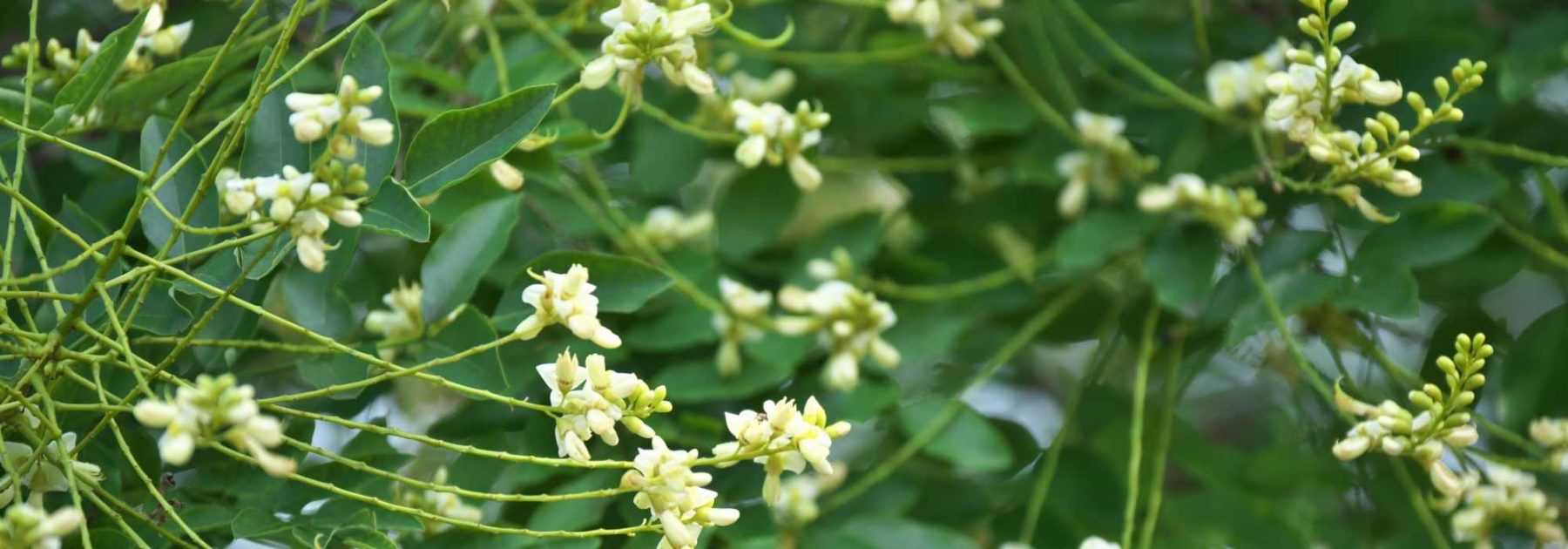
Sophora: Planting and Growing
Contents
The Sophora in a few words
- The sophora is an ornamental tree or bush with delicate foliage beautifully divided into leaflets
- Depending on the species, it adopts a weeping, majestic or prostrate habit
- Once mature, it rewards us with spectacular white or yellow flowering in clusters, fragrant and highly melliferous, followed by pod chains
- Hardy and easy to grow, it thrives in sunny locations with well-drained soil, even in dry and poor conditions
- With rapid growth, it’s perfect as a standalone specimen, for avenue planting or in containers for dwarf sophoras
Our expert's advice
The sophoras are ornamental trees or bushes prized for their delicate foliage, reminiscent of the black locust. Given warm summers and after about twenty years of cultivation, they reward us with melliferous and fragrant flowering, in white clusters like the Sophora japonica, also known as the Japanese Pagoda Tree or Scholar Tree, undoubtedly the most well-known, or yellow in the case of the Sophora microphylla ‘Sun King’.
Also discover the superb variety Sophora japonica ‘Pendula’, appreciated for its beautiful weeping habit that provides dappled shade and makes an excellent shade tree for large gardens. There is also the dwarf Sophora such as the variety ‘Little Baby’, suited to small gardens and container cultivation.
They form trees ranging from 1.50 m to 20 m tall depending on the cultivar, suitable for avenues, groves, borders, or even containers.
These are full-sun plants, to be planted in warm locations. Hardy and easy to grow, they thrive in well-drained soil, even dry and poor. Once established in the garden, they require very little maintenance.
Discover our Sophoras – they deserve a prime spot in your garden or on your terrace!
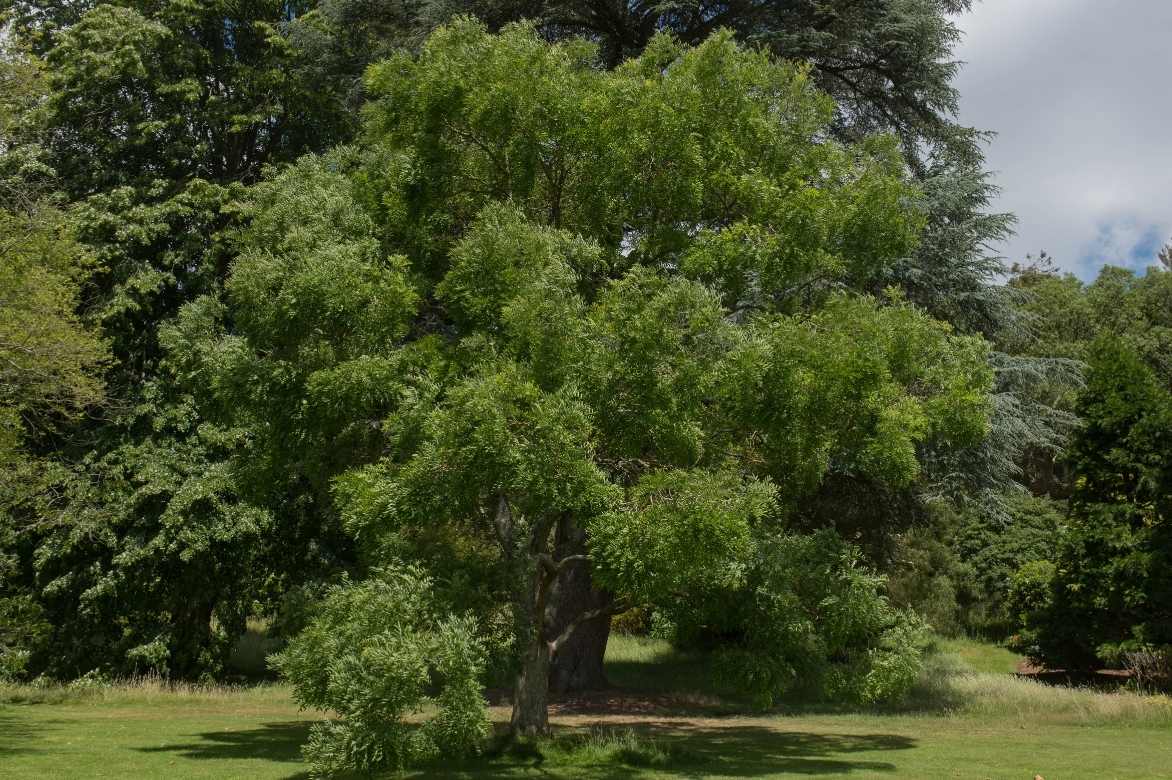
Sophora japonica
Description and botany
Botanical data
- Latin name Sophora
- Family Fabaceae
- Common name Sophora, Pagoda tree
- Flowering spring or summer
- Height 1.50 to 20 m
- Exposure Sun
- Soil type Rich, light, well-drained
- Hardiness -15 °C
The Sophora is an ornamental tree or bush belonging to the Fabaceae family, like Albizias, beans, peas or wisteria. The genus includes between 30 and 50 species of evergreen or deciduous trees and bushes, native to temperate and warm regions of China, Korea or New Zealand. In the wild, this bush is found in various habitats ranging from coastal forests to arid plains, rocky slopes or dry hills and woodlands.
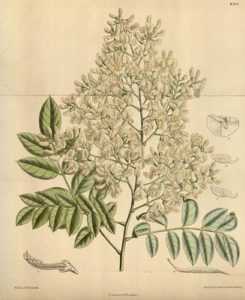
Sophora japonica, botanical plate
Among the most widespread is the Japanese pagoda tree, Sophora japonica, also called the Chinese scholar tree. This is a magnificent tree for parks and large gardens, introduced to our Jardin des Plantes in Paris and the Palace of Versailles in the mid-18th century. A remarkable old specimen can still be found at Château de Montry in Île-de-France. It has produced several interesting cultivars such as the Weeping pagoda tree (Sophora japonica ‘Pendula’), characterised by its long trailing branches reaching the ground. Among other species, we also find Sophora davidii, or David’s sophora, a deciduous bush, and Sophora microphylla, the small-leaved sophora or “Kowhai”.
Their size varies depending on the species and cultivars, ranging from tall trees to dwarf trees, from stocky to slender. The Japanese pagoda tree is a vigorous tree measuring 8 to 25 m tall, with a spread of 10 to 15 m in optimal conditions, while Sophora microphylla ‘Sun King’, also called ‘Hilsop’ cov, reaches a mature height of around 3 m, when the ‘Little Baby’ variety will not exceed 1.25 m in all directions at maturity. In our latitudes, Sophoras tend to maintain reasonable proportions and not exceed 10 m in height.
The habit is bushy, regular and rounded in the Japanese pagoda tree, but also varies depending on the variety or species. The Sophora japonica ‘Pendula’ has a trailing habit, tiered and irregular, with branches up to 12 m long, while the Sophora prostrata has a prostrate and twisted habit.
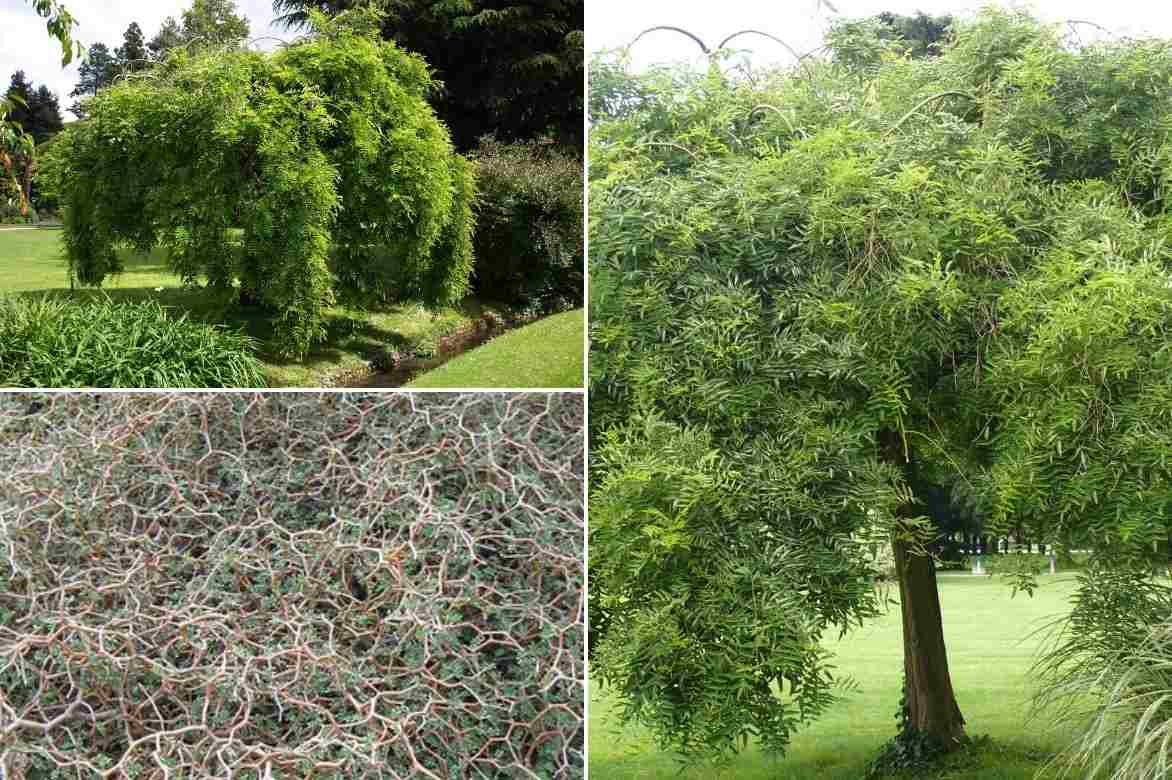
Top left Sophora pendula, bottom left Sophora prostata from the Jardin des Plantes in Paris (© Leonora Enking), and right Sophora japonica
Growth is generally rapid and it has a long lifespan of up to 500 years. Its roots are running and, like all Fabaceae, they have the ability to fix atmospheric nitrogen, meaning this plant does not require nitrogen fertilisers.
The branches are trailing, weeping or grow in a zig-zag pattern. The branches are often twisted and the fissured trunk often becomes gnarled with age. The shoots are characteristic in the Japanese pagoda tree with their green colour dotted with whitish lenticels in young trees.
As Sophora is very close to Acacias and Albizias, it also has very decorative foliage, particularly light, which closely resembles theirs. The foliage is evergreen to semi-evergreen depending on winter severity or deciduous. It appears late, in May or even early June. It has alternate, pinnate, compound leaves with lanceolate or rounded leaflets, measuring 7 to 25 cm long. They somewhat resemble fern foliage but can especially be confused with that of the black locust. The number of leaflets (from 9 to 50) can vary depending on the variety. The Sophora prostrata stands out with its foliage divided into tiny leaflets giving it the appearance of a bonsai.
They are bright green to dark glossy green, or downy in Sophora microphylla. The leaves may fall before yellowing, as with many nitrogen-fixing trees.
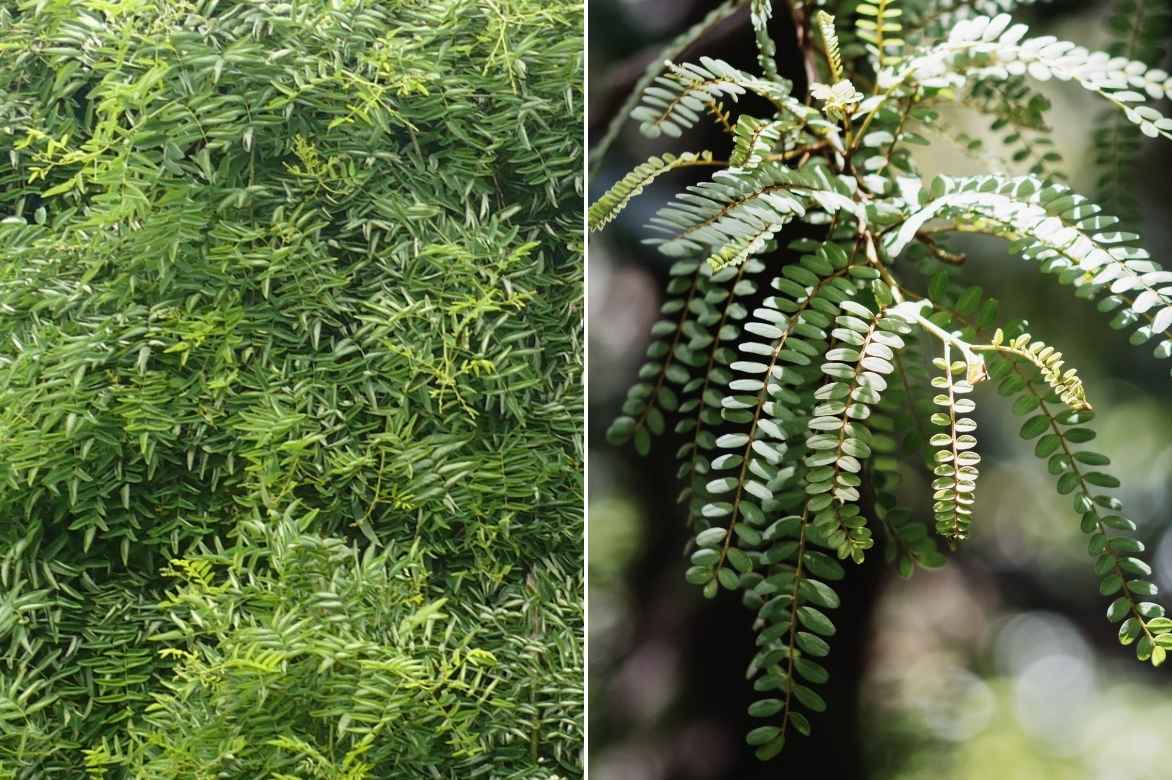
Foliage of Sophora japonica and Kowhai
Whether deciduous or evergreen, Sophoras are particularly floriferous bushes. Flowering is rare and only occurs when the tree is around twenty years old and after long, very hot summers. Flowering begins about a month after leafing. Long-lasting, it starts as early as February-March for the early dwarf ‘Little Baby’, and continues all summer from August to October, depending on the region and species.
It appears as small flowers gathered in terminal panicles, either pendulous or upright, 5 to 30 cm long. We distinguish Sophoras with small white flowers and those with large yellow flowers. The cluster is composed of small papilionaceous or pea-like flowers, typical of Fabaceae, creamy white or bluish-white, or long bell-shaped flowers with reflexed lobes in chick-yellow. In New Zealand, the yellow Sophora flower is the national flower.
Sophora flowers are fragrant. They produce nectar and are a delight for pollinating insects. This tree is sometimes nicknamed the “honey tree”, alluding to this flowering as sought after by foragers as that of the black locust from which a highly prized honey is extracted.
From September-October, the tree produces fruits which are fleshy pods 5 to 20 cm long, green then brown, moulded to the shape of the seeds. They resemble pearl necklaces or rosaries. You can harvest the seeds and store them for sowing in spring.
Main species and varieties
[product sku=”782111″ blog_description=”A smaller variety with more evergreen foliage than the type. It’s a small garden tree!” template=”listing1″ /]
[product sku=”7818161″ blog_description=”A small tree with a trailing habit, full of charm and elegance! Its picturesque silhouette is well-suited as a standalone feature in a short grass meadow in medium-sized gardens.” template=”listing1″ /]
[product sku=”8431811″ blog_description=”A dwarf but less hardy version of the Pagoda tree. With its bonsai-like appearance, it will be perfect for adding an original touch to the mineral decor of a large rockery in a mild climate or in a container on a terrace.” template=”listing1″ /]
Discover other Sophora
View all →Available in 2 sizes
Available in 2 sizes
Available in 2 sizes
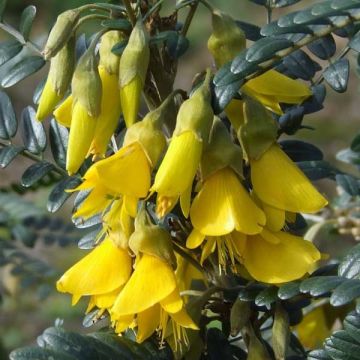
Available in 1 sizes
Planting the Sophora
Where to Plant It?
Most Sophoras are hardy trees, tolerating cold temperatures in the order of -15 to -20°C. This tree is relatively resistant to cold winds, early or late frosts, and occasional droughts once established, making it suitable for cultivation in most regions. However, as its root system is shallow, it’s best planted in sheltered spots to avoid strong winds that might uproot it. The Sophora microphylla, on the other hand, tolerates salt spray, unlike other species.
This is a sun-loving tree that thrives in hot summers. Plant it in full sun, though it can tolerate partial shade in more exposed regions. The Sophora japonica ‘Pendula’ provides excellent shade and is well-suited to southern areas.
Undemanding, it grows in almost any soil, even dry and poor ones. However, it will reach its full potential in fertile, deep, moist, well-drained soil with a slightly acidic tendency.
It dislikes highly chalky soils and waterlogged, compacted earth that suffocates the roots in wet seasons.
It tolerates urban pollution, making it an excellent street tree. It also works beautifully as a standalone specimen or within a shrub border. Some varieties are well-suited to container growing for balconies and terraces.
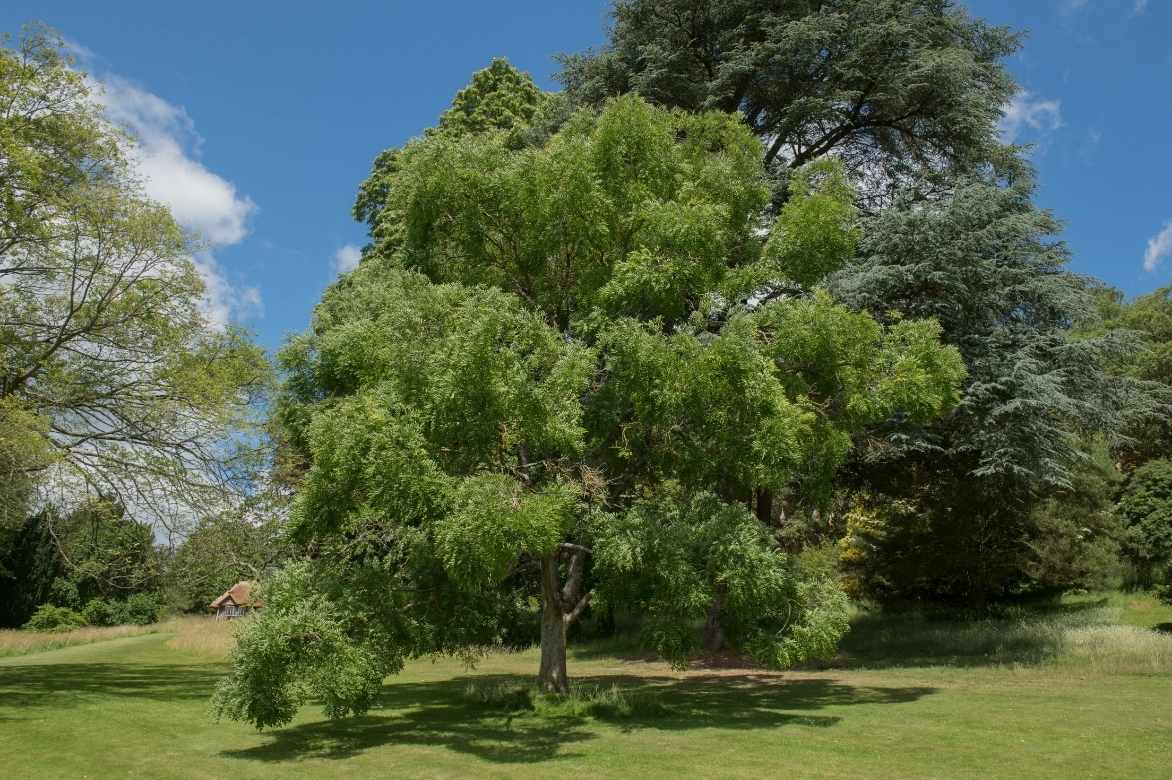
Sophora japonica
When to Plant a Sophora?
Plant in March-April, at the latest by May, once all risk of frost has passed, or in autumn from September to November to ensure deep rooting before winter.
How to Plant It?
In the Ground
Sophoras are typically planted as standalone specimens to showcase their elegant shape. If planting in groups or rows, allow sufficient spacing between trees.
- Dig a planting hole two to three times the size of the root ball, at least 80 cm in all directions
- Add gravel or pozzolana to the base to improve drainage
- Place the root ball in the hole
- Install a stake
- Backfill with garden soil mixed with good compost
- Water thoroughly, then regularly to encourage establishment
In Pots
Compact Sophora varieties make striking container plants for patios, though they may need winter protection in very cold regions.
- Choose a large pot and add a drainage layer at the base
- Plant in a compound substrate of 50% garden soil and 50% potting compost, with some coarse sand
- Water regularly during the growing season, reducing in winter
- Move your Sophora to a bright, cool, frost-free space during severe cold
Maintenance, pruning and care
To encourage its establishment, water generously during the first year, especially during hot and dry periods. We recommend watering 1 to 2 times a week. After the first summer following planting, it will be content with rainwater and won’t require additional watering. You can also apply mulch around the base of the tree to keep the soil cool. The Sophora does not need fertiliser.
Pruning the Sophora is not strictly necessary. If you wish to reduce the branches, carry out maintenance pruning after flowering:
- Simply prune dead or diseased wood
- Avoid cutting large branches
- Remove tangled or crossing branches within the branches
How to prune a weeping Sophora?
- Prune hard in the early years to strengthen the framework
- Remove shoots that appear on the trunk
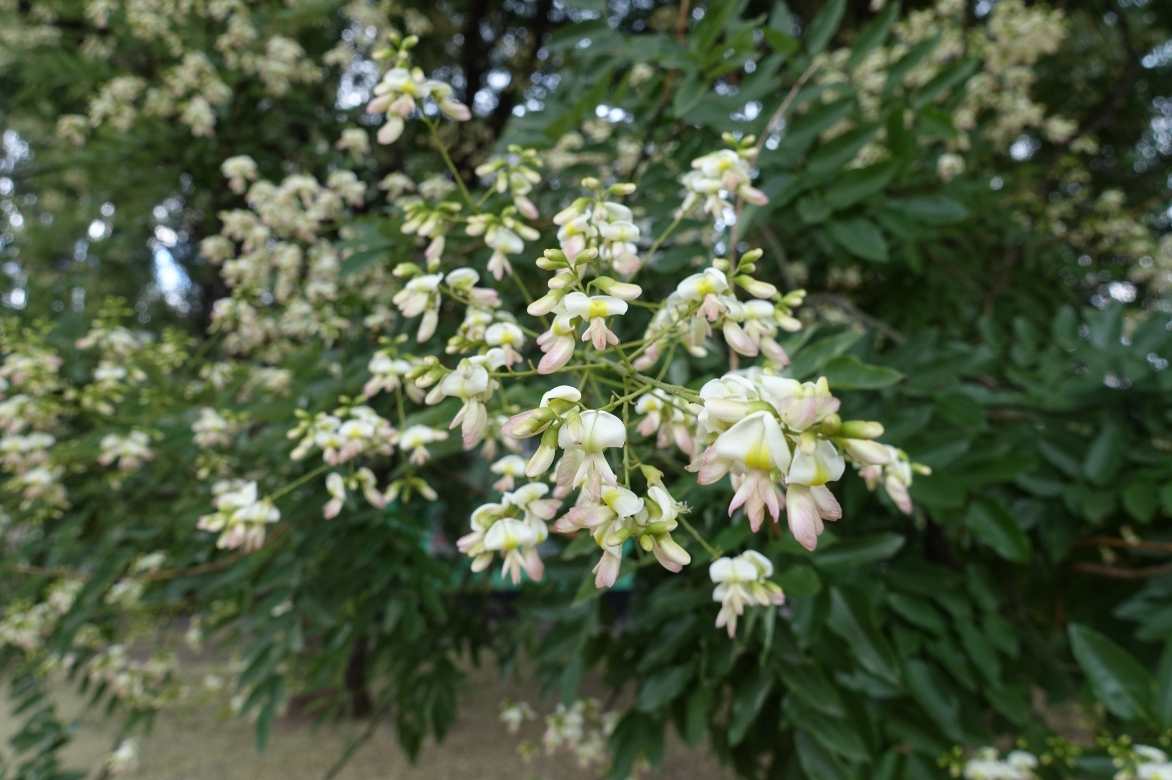
Flowering of Sophora japonica
Diseases and potential pests
When it comes to diseases, the Sophora is not susceptible to any. Occasionally, scale insects may attack it. You can treat by spraying black soap on the foliage.
Propagation
The Sophora propagates by sowing, which is easier to succeed than grafting.
Sowing
If you already have a specimen in your garden, harvest the seeds present in autumn in the dried pods. The seeds are sown in spring after abrasion with sandpaper. Sow the seeds on a layer of compost, then cover with 2 cm of soil. Place the sowings in a bright, warm, and sheltered location (at least 18°C). Keep the substrate moist until germination. Transplant the seedlings into individual pots once they are large enough to handle. Plant out in open ground when the seedlings are at least 50 cm tall.
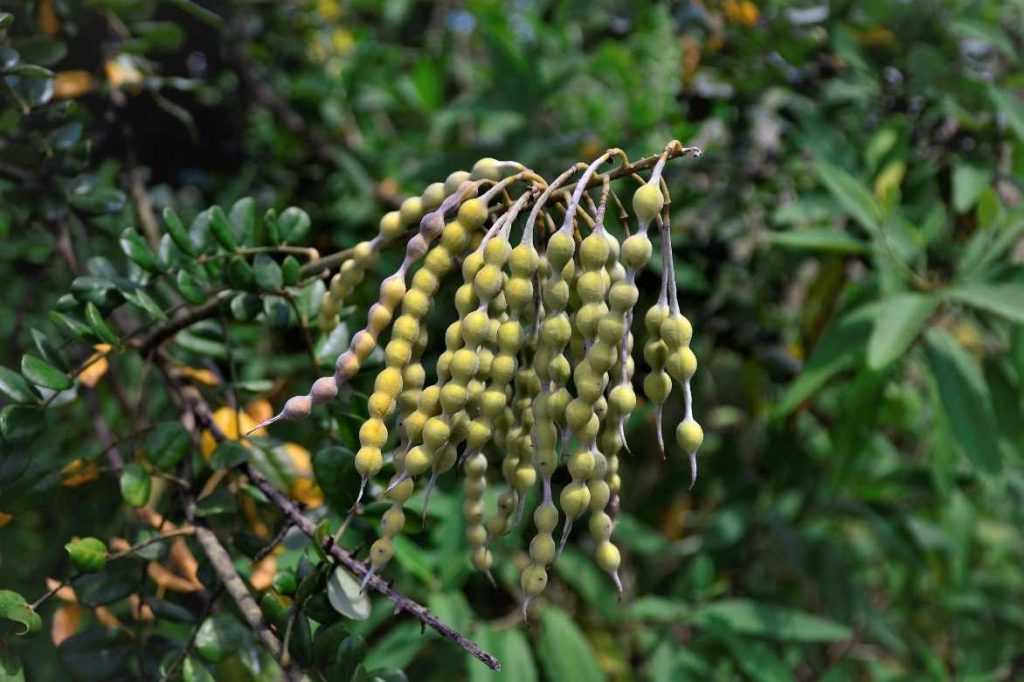
Pods of Sophora tomentosa
Garden Companions
Depending on the variety, Sophoras are suitable for both small and large gardens. They naturally find their place as standalone specimens, like the Pagoda Tree or Sophora japonica ‘Pendula’. As they tolerate pollution well, they are ideal for urban gardens.
They also thrive in flowering thickets and poor soil, paired with other low-maintenance yet highly ornamental trees or bushes such as forsythias, which flower at the same time as the earliest Sophoras. They complement beautifully with bushes like brooms, golden chains (Laburnum anagyroides), and with early-flowering yellow perennials such as spurges, or a coronilla, a small bush from the same family. Surround them with spring bulbs like daffodils or botanical tulips.
You can provide a backdrop of evergreen bushes or conifers such as cypresses, thujas, yews, or junipers, or with Ninebarks, which will contrast with their green leaves.
Dwarf forms like ‘Little Baby’ can accompany in a Zen-inspired border perennial plants with colourful foliage such as Heucheras, ornamental grasses, or Phormiums for an exotic touch.
Did you know?
The Japanese pagoda tree has a history as a park and avenue tree. In the past, the wood of the Japanese pagoda tree was used for constructing timber frames and a yellow dye was extracted from its floral buds to colour bristle (Sophora is said to mean “sulphur yellow”). In Māori pharmacopoeia, this tree is renowned for its anti-inflammatory and antiseptic properties. All parts of the young plant are purgative.
Beware of the presence of alkaloids on Sophora microphylla, which make the young plant toxic.
Useful resources
- Discover our range of Sophoras
- Advice sheet: Trees that thrive in full south-facing exposure
- Advice sheet: Trees with parasol-shaped habit
- Subscribe!
- Contents


































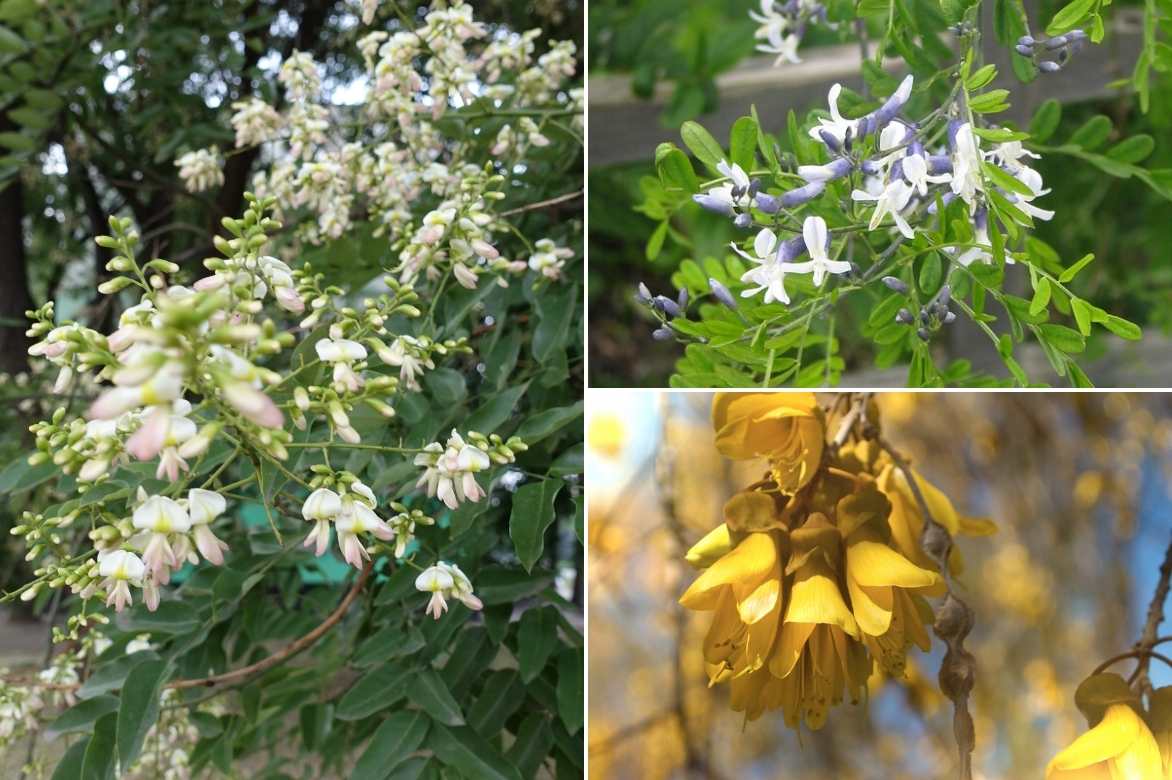
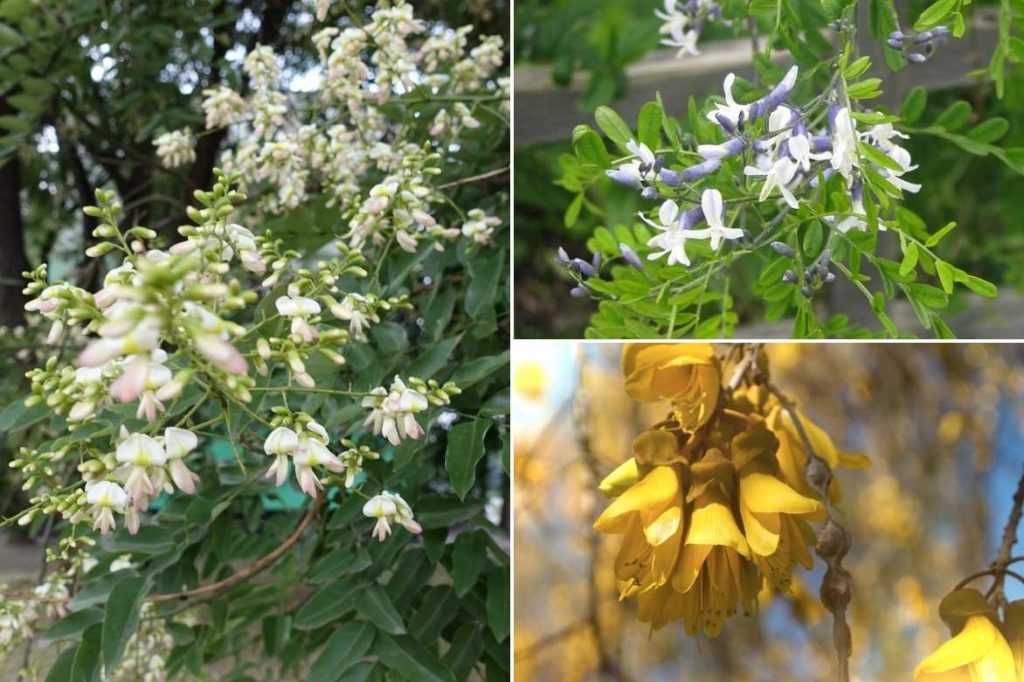
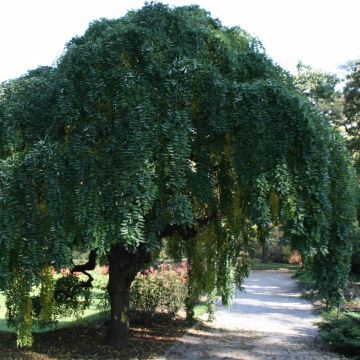
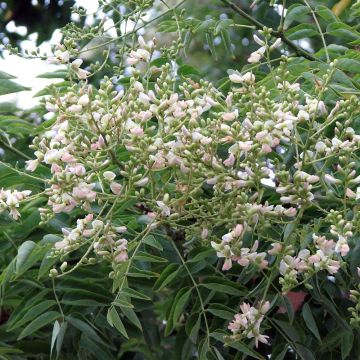
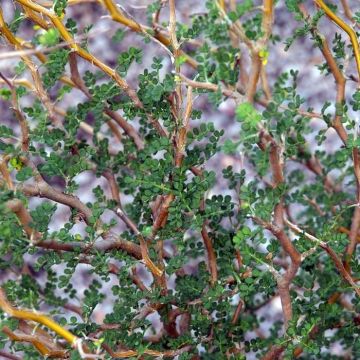
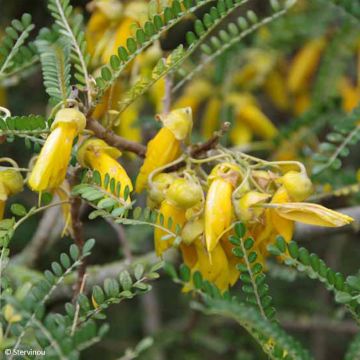
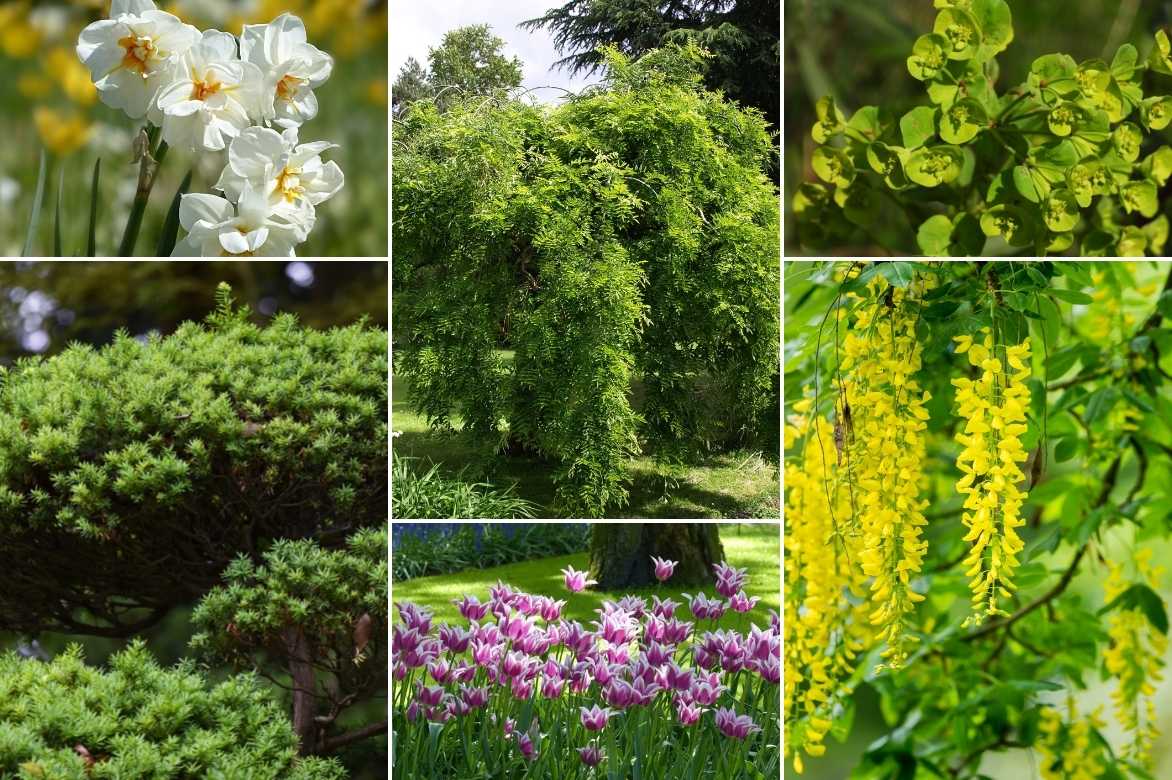
Comments